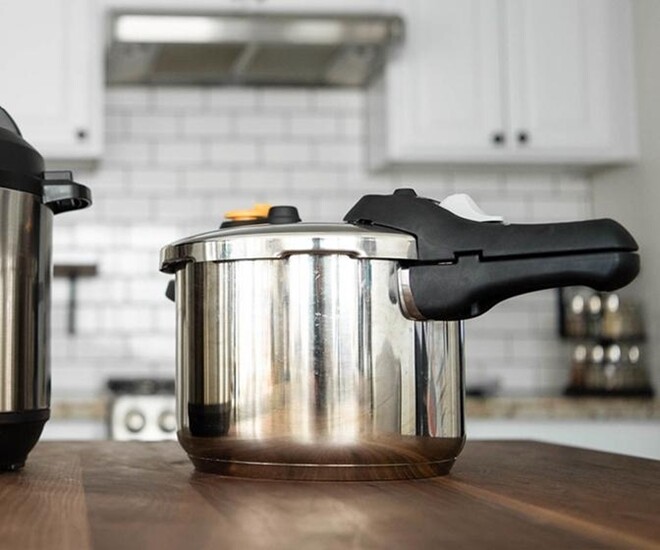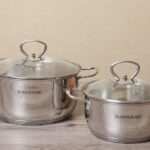After extensive research and experience, I’ve realized that when buying a pressure cooker, following the “6 buys – 6 don’t buys” rule can be incredibly beneficial.

1. For traditional pressure cookers, opt for stainless steel over aluminum
Traditional pressure cookers typically come in two main materials: aluminum and stainless steel. The most significant difference between the two lies in their heat conduction, durability, and cooking pressure.
Specifically, aluminum has a high thermal conductivity of up to 160W/m·°C, allowing the pot to heat up quickly but also losing heat just as fast. Consequently, heat is not retained for long, resulting in increased cooking time and energy costs. On the other hand, stainless steel has a much lower thermal conductivity of only 17W/m·°C. However, it retains heat better, leading to energy and time savings during cooking.

Nowadays, some pressure cookers feature a composite stainless steel base, which improves heat conduction and distribution. However, this design may lead to potential issues like flaking or a damaged base. When the base material changes, the pot’s durability, corrosion resistance, and heat retention decrease, resulting in a shorter lifespan. Therefore, consumers should avoid choosing this type of cooker.
Additionally, the cooking pressure differs between the two types of pots. Stainless steel cookers have a cooking pressure of 100kPa, while aluminum ones only reach 80kPa. This means that, under the same cooking conditions, a stainless steel pressure cooker will cook food faster and save more time and energy than an aluminum one.

2. For electric pressure cookers, avoid choosing flat-bottom heating or single-segment IH heating
Electric pressure cookers primarily use two heating methods: bottom heating and IH heating (internal heating technology).
Bottom heating works by using a heating plate to transfer heat to the pot’s base, which then cooks the food. However, there are two designs for the heating plate: flat and concave.
Flat plates have a small contact area, resulting in uneven cooking and often leading to soft centers and hard bottoms for dishes like rice. Conversely, concave plates have a larger contact area, ensuring more even cooking. Consequently, rice cooked in a pot with a concave plate will have better elasticity, expansion, and shine than one with a flat plate.

IH heating is similar to induction cooking technology, where an electric current creates an electromagnetic field that directly heats the pot’s interior, cooking the food. This technology offers advantages like high power and even heat distribution, resulting in evenly cooked, plump, and tasty rice. However, IH heating is more expensive and can be noisy during operation.
IH heating is divided into two types: single-segment and multi-segment. Single-segment heating usually has a smaller heating coil, leading to uneven heat distribution and potentially unevenly cooked food.
Therefore, I recommend consumers choose products with concave bottom heating and multi-segment IH heating to ensure the best cooking quality.

3. Choose a stainless steel inner pot for soups and a ceramic inner pot for rice
When selecting a pressure cooker, consumers should carefully consider the different types of inner pots available. Currently, there are four popular options: aluminum alloy inner pots, stainless steel (SUS304) inner pots, ceramic inner pots, and composite inner pots.
– Pros and cons of stainless steel inner pots
Stainless steel (SUS304) inner pots have no coating, excellent heat resistance, corrosion resistance, and high-pressure tolerance. They heat up slowly and retain heat effectively, making them ideal for soups and stews. However, stainless steel pots are not the best choice for cooking rice due to their poor heat conduction and uneven heat distribution, which can lead to burnt rice in the center.
However, when combined with water membrane technology and temperature sensors, stainless steel pots can provide excellent cooking results.

– Pros and cons of ceramic inner pots
Pressure cookers with ceramic inner pots are treated with surface technology to enhance their infrared heating capabilities. The thermal efficiency of this type of pot is three to four times higher than that of regular hard inner pots.
One of the biggest advantages of ceramic inner pots is their safety and ease of cleaning. They also have high heat resistance, are scratch and abrasion-resistant, and can preserve food for extended periods. Rice cooked in a ceramic pot tends to taste better. However, it’s important to note that ceramic products are fragile and can break if dropped.
– Pros and cons of aluminum alloy inner pots
Aluminum alloy inner pots are inexpensive and have excellent heat conduction. However, they usually have a Teflon coating. If this coating is damaged, it can release aluminum elements, which can be harmful to health over prolonged periods.

– Pros and cons of composite inner pots
In addition to the three types of inner pots mentioned, there are also composite inner pots made of different coating materials. The main differences lie in the quality and shape of the coating material.
Common coating materials include PEEK (non-toxic), PFA, and PTFE. In terms of shape, inner pots can be flat, spherical, or tubular.
Comparing the durability of these coatings, PEEK has a lifespan of up to 10 years, followed by PFA with 5 to 8 years, PTFE with 3 to 5 years, and ceramic coatings with approximately 3 years.
Regarding safety and hygiene, the ranking is: ceramic > stainless steel > PEEK > PFA > PTFE. For heat efficiency, flat inner pots are the most effective, followed by spherical and tubular pots.
4. Choose a pressure cooker with practical functions instead of multiple complex features
In my opinion, a quality pressure cooker doesn’t need to have numerous complex functions. Instead, it should focus on essential features like cooking rice, soups, porridge, and stews. Other complicated functions often increase costs without providing real value.
The more functions a cooker has, the more components it will have, leading to a higher likelihood of malfunctions and higher maintenance costs. For instance, imagine using a pressure cooker for frying. Sharp objects like bones or stirring utensils can scratch the inner coating, affecting the pot’s lifespan. Therefore, choosing a pressure cooker with practical functions is essential.

5. Choose a pressure cooker that is easy to clean instead of one that is difficult to scrub
When purchasing a pressure cooker, opting for a product that is easy to clean is crucial. We should avoid cookers that are challenging to sanitize and instead look for the following features to facilitate pressure cooker cleaning:
– Choose a cooker with a detachable clear lid. This makes it easy to clean the crevices inside the lid; simply detach and rinse.
– Opt for an inner pot with handles. This offers three benefits: easy removal for cleaning, no burns when handling food, and added convenience during cleaning.
Choosing a suitable pressure cooker not only saves time but also ensures food hygiene and safety. Consider your options carefully before making a purchase.

6. Buy pressure cookers from reputable brands with nationwide after-sales service, avoiding unbranded products
When deciding to buy a pressure cooker, focus more on after-sales service than just the functions, price, or specifications. One crucial factor is choosing a brand that offers nationwide warranties instead of those that require sending the product back to the factory for repairs.
Purchasing a pressure cooker from a brand with nationwide after-sales service brings several benefits. Firstly, consumers can easily access repair services at multiple warranty points across the country, saving time and money.
With convenient after-sales service, consumers can have peace of mind when using the product, reducing financial and time burdens. Therefore, choosing a pressure cooker from a brand with nationwide after-sales service is a smart decision for modern consumers.
The Ultimate Guide: 3 Simple Steps to Remove Stubborn Sticker Residue from Your New Stainless Steel Pots and Pans
Introducing the ultimate guide to removing those pesky product information and price tags from your household items! Say goodbye to unsightly sticker residue on your pots, pans, and kitchen utensils. With our simple and effective methods, you’ll be able to effortlessly remove those stubborn adhesive marks and restore your belongings to their original glory. Join us as we explore the top 3 ways to eliminate sticker glue stains from your stainless steel cookware. Get ready to bid farewell to those annoying tags and hello to a clean and pristine kitchen!






































